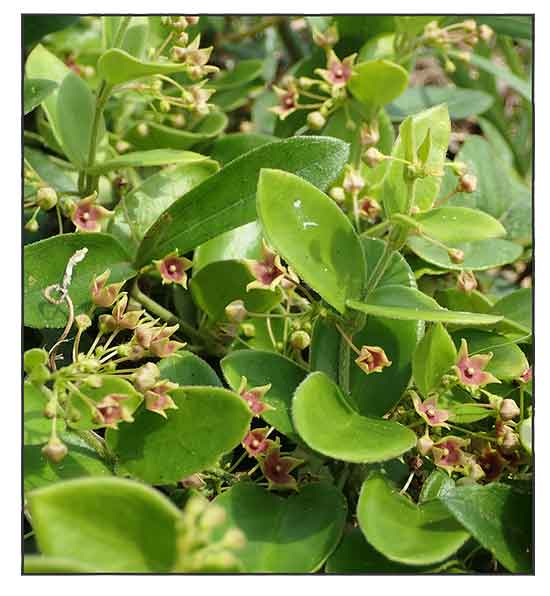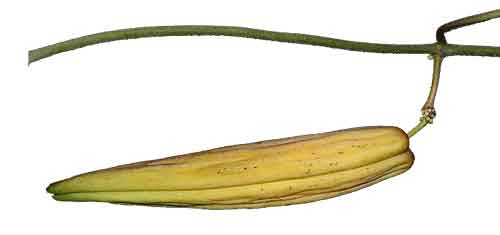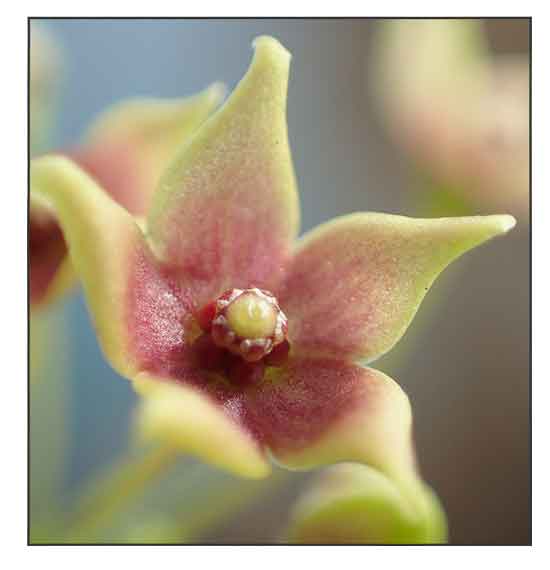Gen info
- Vincetoxicum is a genus of plants in the family Apocynaceae. It comprises over 100 species. Although sometimes included in Cynachum, chemical and molecular evidence show Vincetoxicum is more related to Tylophora, now included in Vincetoxicum. (3)
- Etymology: The generic name derives from Latin, meaning "poison-beater" referring to the plants' supposed antidotal effects against snakebites. (3) The specific epithet hirsutum means hirsute or hairy.
 Botany Botany
• Hairy Ipecac is a liana up to 5 m long, rusty hairy, or velvety except for upper leaf surface and sometimes seed-pods. Leaf-stalks are 0.5-3 cm, leaf blade ovate, 2.5-12.5 x 1.2-9 cm, base heart-shaped, tip pointed or with a short tapering part, and mucronate. Lateral veins are 4-6 pairs. Inflorescences are 4-13 cm across, carried on stalks 0.5-2 cm long. Rachis is simple, zigzag, occasionally forked. Cymules are stalkless, racemelike, dense, many flowered. Flower-stalks are threadlike, 5-10 mm. Sepals are long-pointed to ovate, ciliate. Glands are 5 or absent. Flowers are yellowish or yellow-green, pinwheel shaped, about 5 mm across, hairless or velvety. Flower-tube is about 1 mm, petals oblong-ovate or ovate, about 1.5-2.5 x 1-1.2 mm, blunt. Corona lobes are ovoid, pouched, apex obtuse, covering base of anthers. Seed-pods are lance-shaped to oblong-lanceshaped in outline, 4-7 cm x 3-12 mm, velvety or hairless, tip sometimes recurved.Â
(Flowers of India)
Distribution
- Native to the
Philippines. (1)
- Also native to Assam, Bangladesh, Cambodia, China South-Central, China Southeast, East Himalaya, Hainan, India, Jawa, Malaya, Myanmar, Nepal, Pakistan, Taiwan, Thailand, Vietnam, West Himalaya. (2)
 Constituents Constituents
- Study of leaves and st3s isolated two new septicine alkaloids and one new phenanthroindolizidine alkaloid, tylophovatines A, B, C (1,2, and 5), respectively, along with two known septicine and six known phenanthroindolizidine alkaloids. (see study below) (5)
-
Study of Tylophora hirsuta isolated seven minor alkaloids: known alkaloids 14-hydroxyisotylocrebrine, (+)-isotylocrebrine, (−)-tylophorine and 4-desmethylisotylocrebrine have also been isolated in addition to three new alkaloids, namely 14-desoxy-13a-methyltylohirsutinidine, 5-hydroxy-O-methyltylophorinidine and tylohirsuticine. (8)
 Properties Properties
- Studies have suggested anti-inflammatory, cytotoxic, anticancer, antioxidant, antidiabetic, blood pressure lowering, antileishmanial, antimicrobial, insecticidal, antiamoebic properties.
Parts used
Roots, leaves, stems.
Uses
Edibility
- No reports found on plant edibility.
Folkloric
- No reported folkloric medicinal use in the Philippines.
- Traditionally, root decoction used for treatment of asthma, coughs, leukemia, traumatic injuries, rheumatoid backaches, abdominal pains.
- Used as antidote for venomous snakeites.
- Applied to skin ulcer and wounds.
Others
- Veterinary: Latex from stems used topically for conjunctivitis in livestock. (4)
Studies
• Anti-Inflammatory / Cytotoxic Against Cancer Cell Lines / Phenanthroindolizidine and Septicine Alkaloids / Leaves and Stems: Study of leaves and st3s isolated two new septicine alkaloids and one new phenanthroindo-lizidine alkaloid, tylophovatines A, B, C (1,2, and 5), respectively. The 11 alkaloids showed in vitro anti-inflammatory activities with IC50s ranging from 84 nM to 20.6 µM through suppression of NO production in RAW 264.7 cells stimulated by LPS and interferon-γ. The compounds also exhibited growth inhibition in HONE-1, BUGC-3, HepG2, SF-268, MCF-7 and NCI-H460 cancer cell lines. Tylophovatine C (5) and 13a(S)-(+)-tylophorine (7) exhibited potent in vivo anti-inflammatory activities in rat paw edema model. (5)
• Attenuation of Alloxan-Induced Diabetes / Antioxidant / Leaves: Study evaluated the antidiabetic potential and antioxidant activities of methanolic and ethyl acetate extracts of T. hirsuta leaves. By DPPH, hydrogen peroxide scavenging and ferric ion reduction, the methanolic extract exhibited higher in vitro antioxidant activities than the EA extract. The ME extract exhibited 83.90% α-amylase inhibitory activity qt 3.2 mg/mL concentration. The ME improved fasting blood glucose, HbA1c, serum α-amylase, lipid profile, liver function biomarkers and kidney functions of diabetic mice. The ME ameliorated diabetes-related oxidative stress by increasing superoxide dismutase and catalase activities and decreasing peroxidase and malondialdehyde levels. Histopath exam showed improved integrity of pancreatic islets of Langerhans and reduced pathological lesions in the liver and kidney of diabetic mice. (6)
• Blood Pressure Lowering Effect / Aerial Parts: Study evaluated the crude hydromethanolic extracts of T. hirsuta aerial parts in spontaneous hypertensive Wistar rats for effects on blood pressure and heart rate. Results showed fall in blood pressure and heart rate, which was attributed to the presence of acetylcholine-like substances and α-amyrin acetate in T. hirsuta. (7)
• Antileishmanial / Insecticida / Antimicrobial / Aerial Parts: Study of methanolic extract of aerial parts showed significant antileishmanial activity against Leishmania major; reasonable insecticidal activity against L. minor; low and non-significant activity against Shigella flexneri and Bacillus subtilis, respectively; and moderate antifungal activity gainst Fusarium solani. No significant general toxicity was observed at tested concentration. (9)
• Antiamoebic / Phenanthroindolizidine Alkaloids / Aerial Parts: Study of isolated fourteen phenan-throindolizidine alkaloids from aerial parts of Tylophora hirsuta and T. indica. All showed activity against Entamoeba histolytica in vitro. Two, tylophorine and tylophorinine, were considerable more effective than standard drugs. However, while tylophorine showed to be very effective against caecal and hepatic infestations in test animals, its considerable toxicity precludes its potential use in man. (10)
Availability
- Wild-crafted.
|

![]()






